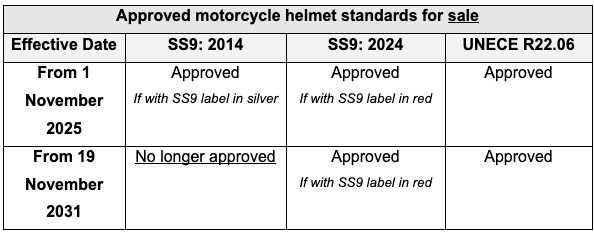Singapore to adopt international helmet standards on Nov 1, giving riders safer and cheaper options
singapore-to-adopt-international-helmet-standards-on-nov-1-giving-riders-safer-and-cheaper-options
#Singapore #adopt #international #helmet #standards #Nov #giving #riders #safer #cheaper #options,
SINGAPORE: From November 1, 2025, motorcyclists in Singapore will be able to choose from a wider range of helmets that meet internationally recognised safety standards, in a move that aims to improve road safety and lower costs for riders.
The Traffic Police (TP) announced that helmets certified under the United Nations Economic Commission for Europe Regulation No. 22 – (Revision 5), 06 series (UNECE R22.06) will be accepted for use in Singapore without requiring local approval tests. This standard, already adopted in places such as the European Union, the United Kingdom, Japan, and South Korea, is regarded as one of the most comprehensive globally. According to the Singapore Police Force’s news release, helmets approved using this standard include stronger protection against rotational impact, improved high-speed impact absorption, and enhanced field-of-vision requirements.
At the same time, Singapore will also introduce the updated Singapore Standards 9: 2024 (SS9: 2024) to eventually replace the existing SS9: 2014. The revised SS9 standards are aligned with UNECE R22.06 and reflect updated testing practices. For instance, penetration tests, where a spike is dropped onto a helmet to check for punctures, will no longer be required, as no local accident cases of penetrative head trauma have been recorded in the past two decades.
During a two-year transition period from November 1, 2025, to November 18, 2026, both SS9: 2014 and SS9: 2024 certified helmets will be accepted. Helmets tested under SS9: 2014 will remain valid for sale until November 19, 2031. This is in light of the two-year transition for laboratories to attain SS9:2024 accreditation, on top of each test yielding a five-year validity per approval.

New labelling system for helmets
To make identification easier, new labelling rules will take effect. Helmets certified under SS9: 2014 will carry a silver tamper-proof sticker, while those certified under SS9: 2024 will carry a red sticker. Both must display the “SS9” logo along with test and serial numbers.

For UNECE R22.06 helmets, riders should look for an E-mark sewn onto the chin strap, showing the approving country, approval number, helmet type and production serial number. Visors are also required display a corresponding E-label.

Why this matters for riders
By adopting UNECE R22.06, helmets sold in Singapore will no longer need to undergo local approval testing. This will then reduce duplication and redundancy, ultimately lowering the costs for local motorcyclists.
Furthermore, with this move, riders can expect to see a greater variety of helmets in shops, including models with the latest safety features. This is because there’d be more options available for the people once this policy shift takes effect.
According to the World Health Organization, wearing a quality helmet reduces the risk of death by more than six times and lowers the chance of brain injury by up to 74%. With motorcyclists forming a disproportionate share of road fatalities in Singapore, the updates are intended to make a direct impact on safety.
Advisory to motorcyclists
TP reminded riders to replace helmets every five years, even if they appear to be in good condition, as materials deteriorate over time due to exposure to weather and sweat.
Engagement sessions will be held with helmet retailers, driving schools, and delivery rider groups this month to ensure that motorcyclists understand the new standards and labelling requirements.
In a statement, TP said: “Helmet use is not just a legal requirement, but a commitment to returning home safely to your loved ones every day. We urge all motorcyclists to take it seriously.”
Netizen reactions
The announcement sparked active discussion online, with many riders welcoming the move but also questioning the rollout. One user quipped, “Took them long enough,” suggesting that Singapore is only now catching up with international norms. Another asked, “How will they enforce this? Interesting,” reflecting curiosity over whether checks will be consistent on the ground.
Some expressed relief that the change was finally happening. One simple but telling comment on Facebook noted, “Finally,” emphasising how this was a change that was bound to happen. However, some raised concerns about the costs involved, with a rider remarking, “Paying more for just a sticker?” This points to two things: an overall scepticism about whether labelling changes might translate into higher retail prices, but also the perverse incentive for some people to create fake stickers and sell them at a lower price
Together, the mix of responses highlights both optimism and caution: Riders are glad to see international standards adopted but remain watchful about how these changes will play out in practice.
To read the full details of the new policy, check out the Singapore Police Force’s official news release.
Read also: SMRT bus captains recognised at Singapore Road Safety Council Awards for decades of safe driving
